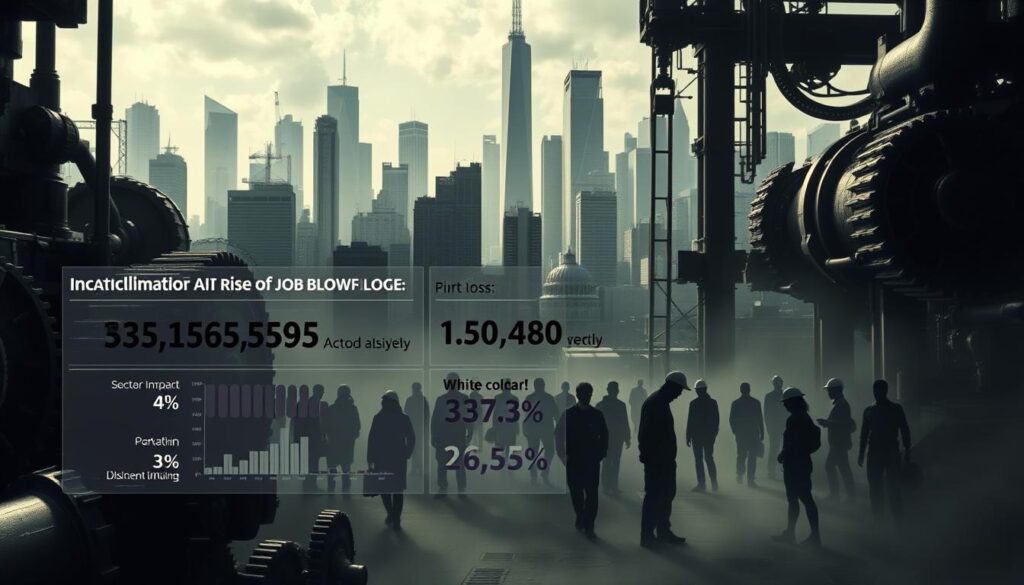Did you know that a staggering 47% of jobs in the United States are at risk of being automated in the next two decades? This reality presents a profound challenge, particularly for those in white-collar roles. As AI taking over technologies rapidly advance, the landscape of employment is undergoing dramatic shifts. Understanding these changes in employment trends is crucial, as they outline not just job losses but also the potential for new opportunities within the workforce future.
The imminent threat to many office jobs calls for an urgent re-evaluation of career paths and job security. As companies increasingly adopt AI solutions, the urgency to grasp the implications of these transformations grows. This article sets the stage for a comprehensive exploration of how AI advancements will redefine white-collar employment and what you can do to prepare for what’s ahead.
Key Takeaways
- Nearly half of U.S. jobs could be impacted by automation in the upcoming years.
- AI technology is fundamentally changing employment trends across industries.
- Job security may be at risk, particularly in traditional white-collar roles.
- The workforce future hinges on adaptability and the acquisition of new skills.
- Understanding AI’s role is critical for navigating employment changes.
The Rise of AI in the Workplace
The integration of AI advancements into the workplace is reshaping how businesses operate and how employees perform their roles. Cutting-edge technologies such as machine learning, natural language processing, and robotic process automation are rapidly transforming tasks that were once exclusively handled by humans. These innovations streamline operations, enhance efficiency, and drastically improve decision-making processes across various sectors.
Overview of AI Advancements
AI advancements represent a significant leap in technology, leading to substantial improvements in productivity. Machine learning algorithms can analyze vast amounts of data faster than any human possible, identifying patterns and insights that drive strategic decisions. Natural language processing enables machines to understand and generate human language, streamlining customer service and communication. Furthermore, robotic process automation eliminates repetitive tasks, allowing employees to focus on more critical functions. Examples of these advancements can be seen in industries like finance, healthcare, and marketing.
Impact on White-Collar Jobs
The job effects of these technological changes cannot be underestimated. As workplace automation becomes more prevalent, many white-collar jobs face the risk of obsolescence. Roles in data entry, bookkeeping, and even project management are being supplemented or replaced by AI systems capable of carrying out these functions more efficiently. The future of work appears increasingly reliant on AI tools, prompting employees to adapt to new roles that require a blend of human creativity and technological acumen. As a result, the transition may shift the workforce dynamics and necessitate a reevaluation of job roles within many organizations.

Understanding Automation’s Role in Job Displacement
As businesses strive for increased efficiency, automation emerges as a powerful force, significantly impacting job displacement across various sectors. By streamlining operations and reducing costs, many organizations turn to automation technologies, fundamentally altering the landscape of work. This transformation influences not only the way tasks are performed but also the nature of employment in numerous industries affected by these changes.
How Automation is Reshaping Industries
Automation has begun to penetrate multiple sectors, creating widespread implications for the workforce. In finance, algorithms perform tasks such as transaction processing and data analysis. The healthcare industry sees automation in patient record management and diagnostics, enhancing productivity while reducing human error. Retail businesses utilize automated systems for inventory management and customer service, which diminishes the need for traditional roles. These shifts highlight various industries affected, emphasizing their reliance on automation.
Examples of Jobs at Risk
With the rise of automation, many positions face imminent threats. Specific roles at risk include:
- Administrative assistants
- Travel agents
- Factory workers
These examples illustrate how routine tasks can be efficiently handled by machines, leading to substantial job displacement and urging workers to reassess their career paths.

AI Taking Over: A White-Collar Job Bloodbath
The rise of artificial intelligence is associated with profound changes in the labor market, particularly concerning job losses statistics. Current projections indicate that millions of white-collar jobs may face displacement in the years ahead. This trend is noticeably alarming, affecting various sectors and shaking the foundations of established industries.
The Numbers Behind Job Losses
Reports from industry experts and labor organizations highlight staggering job losses statistics. For example, studies anticipate that up to 20 million jobs in finance, marketing, and administration could vanish in the next decade. This can primarily be attributed to the sophisticated capabilities of AI technologies, which can perform complex tasks traditionally managed by human workers.
Industries Feeling the Heat
Certain industries are feeling the weight of these labor market changes more than others. The following sectors are under significant pressure:
- Finance: Automated trading systems and chatbots are reducing the demand for human brokers and customer service representatives.
- Marketing: AI-driven analytics tools streamline campaign management and reporting, potentially displacing marketing analysts and strategists.
- Manufacturing: Robotics in manufacturing facilities continue to evolve, threatening assembly line positions and quality control roles.

As you contemplate the implications of AI on your career and industry, understanding the specific sectors impacted by these technological advancements is crucial. Remaining informed about job losses statistics will help you navigate this changing landscape effectively.
The Changing Landscape of Middle-Class Jobs
The landscape of middle-class jobs has undergone significant transformation over the decades. Once, these roles provided a sense of career stability, complete with benefits and a clear path for advancement. Today, various economic shifts have contributed to an environment where employment security is increasingly elusive. Understanding this evolution reveals the challenges you may face as well as the implications for the future workforce.
From Stable Careers to Precariats
Historically, middle-class jobs offered both reliability and growth opportunities. However, factors such as globalization and automation have drastically changed the job market. The emergence of the “precariat” highlights the growing number of individuals in unstable employment situations.
- Economic policies have influenced job availability and security.
- Technological advancements have automated tasks once performed by humans.
- Outsourcing has shifted many stable jobs overseas.
This shift toward precarious employment challenges assumptions about career stability, emphasizing the need for adaptability in skills and expectations.
Historical Perspective on Middle-Class Jobs
Examining the history of middle-class jobs provides insights into the current economic landscape. A few decades ago, these positions often came with a promise of upward mobility and relative job security. In today’s climate, shifts toward gig work and short-term contracts often prevent employees from achieving long-term employment security.
The following table outlines the key differences between historical and contemporary perceptions of middle-class jobs:
| Aspect | Historical Middle-Class Jobs | Contemporary Middle-Class Jobs |
|---|---|---|
| Job Security | High | Low |
| Career Advancement | Clear pathways | Uncertain and sporadic |
| Benefits | Comprehensive | Limited or Nonexistent |
| Work Environment | Stable and supportive | Often isolated and competitive |
These changes render the landscape of middle-class jobs precarious, influencing how you navigate your career in uncertain economic times.

Emerging Fields Amidst Job Losses
Amid the turmoil caused by AI and automation, new opportunities arise, particularly in emerging job fields such as technology and artificial intelligence. The tech industry growth has led to an increased demand for skilled professionals in a variety of areas, creating pathways for those willing to adapt to the new job landscape.
Opportunities in Tech and Artificial Intelligence
The expansion of the tech sector showcases numerous career opportunities. Industries actively seek data analysts, AI specialists, and cybersecurity experts. Companies are investing heavily in digital transformation, necessitating a workforce equipped with modern skills that cater to the evolving needs of the market.
The New Skills Required for the Future
To thrive in these emerging job fields, you must cultivate specific skills for the future. Key abilities include:
- Critical thinking
- Adaptability
- Technological proficiency
- Data analysis
- Cybersecurity knowledge
These skills align closely with the demands of the tech industry growth. Companies prioritize individuals who can quickly adapt to changes and leverage technology for innovative solutions.

| Job Role | Industry Demand | Key Skills Required |
|---|---|---|
| Data Analyst | High | Data analysis, critical thinking |
| AI Specialist | High | Machine learning, adaptability |
| Cybersecurity Expert | Growing | Cybersecurity knowledge, problem-solving |
Embracing these new opportunities and required skills will position you favorably in the competitive job marketplace shaped by technology and AI advancements.
How Companies Are Adapting to AI Implementation
As artificial intelligence continues to permeate various sectors, company adaptation becomes essential for maintaining competitiveness. Businesses are increasingly re-evaluating their hiring practices, shifting their focus towards candidates who demonstrate not only technical skills but also a strong inclination to learn and adapt. This evolution is crucial in an environment where technological advancements can render existing roles obsolete.
Shifts in Hiring Practices
In response to AI integration, companies are refining their hiring practices to prioritize attributes that align with the needs of a tech-driven workforce. Employers now seek individuals with:
- Technical proficiency, especially in data analysis and programming.
- Experience in collaborative environments that utilize AI tools.
- A growth mindset, making them adaptable and open to learning new technologies.
This focus enables organizations to build teams capable of navigating the complexities introduced by AI, ensuring they remain agile in a rapidly changing market.
Investing in Employee Reskilling
Beyond hiring, companies are recognizing the need for employee reskilling as a vital component of their adaptation strategies. Many organizations have initiated robust training programs aimed at upskilling existing staff to take on new, AI-related roles. This commitment to development manifests in various ways:
| Company | Reskilling Program Focus | Duration |
|---|---|---|
| Data science and machine learning | 6 months | |
| Accenture | Digital skills and cloud technology | 1 year |
| IBM | A.I. and AI Ethics | Ongoing |
By investing in employee reskilling, businesses not only help their workforce to stay relevant but also strengthen loyalty and morale within their teams. This dual approach of refining hiring practices and fostering a culture of continuous learning ensures a smoother transition into an AI-integrated landscape.

The Psychological Impact of Job Displacement
Job displacement can take a significant toll on mental health. The uncertainty surrounding employment status creates anxiety that can permeate every aspect of life. Individuals may grapple with feelings of inadequacy and worry about their financial future. The job displacement effects extend beyond the workplace, affecting personal relationships and overall well-being. Navigating these emotional challenges requires understanding and effective coping strategies.
Coping with Anxiety in a Changing Workforce
As a worker facing potential job loss, developing coping mechanisms is essential. Techniques such as mindfulness, meditation, and physical exercise can help manage anxiety. Staying connected with friends and family provides emotional support. Seeking professional help from mental health providers can further bolster resilience in the face of job uncertainty.
Support Systems for Affected Employees
Employee support systems can play a crucial role in mitigating the negative impacts of job displacement. Many organizations offer resources such as counseling services, workshops, and community engagement programs. These initiatives assist individuals in processing their experiences and transitioning to new opportunities. Engaging with these support systems allows you to navigate the complexities of job loss with greater confidence.

Preparing for the Future Job Market
In a rapidly changing job environment influenced by technology, job market preparation becomes crucial for your career success. Anticipating the skills that will be in demand ensures that you remain relevant and competitive. A strategic focus on skills development will help you navigate the complexities of the modern workforce.
Essential Skills to Stay Relevant
As sectors evolve, certain skills become essential. In particular, you should focus on:
- Technological Literacy: Understanding new technologies will become a basic requirement in almost every occupation.
- Emotional Intelligence: The ability to empathize and communicate effectively will remain a vital asset in workplace interactions.
- Project Management: Being able to organize, plan, and execute projects efficiently sets you apart from the crowd.
The Importance of Lifelong Learning
The landscape of the job market demands that you embrace lifelong learning. Continuous education not only enhances your skills but also equips you to adapt to changes brought on by AI and automation. Engaging in ongoing training and professional development opportunities will keep your knowledge current and relevant.
| Skill Type | Examples | Relevant Fields |
|---|---|---|
| Technical Skills | Data analysis, software proficiency | IT, Finance, Marketing |
| Soft Skills | Communication, teamwork | Healthcare, Hospitality, Education |
| Management Skills | Strategic planning, budgeting | Corporate, Non-profit, Startups |

Government Response to Job Losses due to AI
As artificial intelligence continues to reshape the workplace landscape, the role of government becomes increasingly crucial. Implementing strong government policies can provide necessary workforce protection to those affected by job displacement. Lawmakers are exploring various strategies to mitigate the impact of technology-driven changes on employment.
Policies for Protecting Workers
Governments are prioritizing policies aimed at safeguarding workers during this transitional period. Key initiatives include:
- Unemployment benefits: These provide essential financial support to individuals who lose their jobs due to automation.
- Job retraining programs: Initiatives that equip displaced workers with skills necessary for in-demand sectors help boost employability.
- Legislative support: Implementing regulations to prevent abrupt layoffs and ensuring a safety net for those transitioning to new jobs represents a significant government commitment.
Funding for Reskilling Initiatives
Another important aspect of government intervention lies in reskilling funding. By investing in educational programs, governments create opportunities for individuals to adapt to the evolving job market. Examples of effective funding strategies include:
- Grants for educational institutions: Financial resources allocated to colleges and training centers enhance the availability of reskilling courses.
- Subsidized training programs: Government partnerships with private sectors can lead to affordable training options for workers, easing the financial burden of upskilling.
- Community workshops: Hosting local sessions for skills development ensures that displaced workers remain engaged and informed about new opportunities.

Global Perspectives on AI Job Displacement
As AI technology continues to evolve, its impact leads to varying degrees of global job displacement across different countries. Nations are adopting distinct international strategies to cope with these changes. Understanding diverse approaches reveals not only the challenges but also the commonality of the AI effects worldwide.
Comparative Analysis of Different Countries
Numerous countries face significant disruptions in their job markets due to AI implementations. For instance, in the United States, many sectors are seeing a substantial shift in job dynamics, particularly in areas like customer service and data analysis. In contrast, nations like Germany emphasize retraining employees through vocational programs to mitigate global job displacement. Here’s a closer look at how various countries are addressing these challenges:
| Country | Strategies Implemented | Outcome |
|---|---|---|
| United States | Investment in AI research and development | Increased job losses in traditional sectors |
| Germany | Vocational training programs for reskilling | Reduced unemployment rates amid AI disruption |
| Japan | Incorporation of AI in collaboration with human workers | Boost in productivity without major layoffs |
| Canada | Government incentives for technology startups | Creation of new job opportunities in emerging fields |
International Responses and Strategies
Response strategies vary not only in scope but also in effectiveness. Countries are exploring policies encompassing education reform, social safety nets, and public-private partnerships aimed at preparing the workforce for an AI-driven landscape. For instance, Australia has launched initiatives to integrate technology literacy into its educational curriculum, ensuring future generations are equipped to navigate a rapidly changing job market influenced by AI effects worldwide. These concerted efforts underline the need for comprehensive international strategies in the face of ongoing global job displacement.

Personal Strategies to Navigate Career Changes
Navigating career changes in today’s evolving job market demands proactive measures. You can effectively manage the challenges brought about by automation and shifting job landscapes through solid networking strategies and a willingness to explore entrepreneurship opportunities. Building connections and leveraging these relationships will open doors to potential job prospects.
Networking and Building Professional Relationships
Establishing a robust network is critical when considering career changes. Engaging with peers, industry leaders, and mentors can provide valuable insights into available job openings and industry trends. Attend industry conferences, workshops, and webinars to meet individuals who share your professional interests. Use social media platforms like LinkedIn to connect with professionals and join relevant groups. Sharing your experiences and knowledge fosters stronger connections, making your network a valuable resource during career transitions.
Embracing Entrepreneurship and Freelancing
Exploring entrepreneurship opportunities can offer a pathway to personal and financial growth. Consider your unique skills or passions as potential business ventures. Freelancing can provide flexibility and the ability to engage with various clients and projects. Create a personal brand that highlights your expertise. Use social media and professional platforms to market your services effectively. Engaging with entrepreneurial communities can offer support, advice, and networking opportunities essential for your success.

Conclusion
As we navigate the profound impact of AI on the workforce, it becomes increasingly clear that the AI job market future presents both challenges and opportunities. The evolution of technology is reshaping white-collar roles, leading to significant job displacement. Throughout this article, the necessity for both individuals and organizations to adapt has been emphasized, highlighting the need for proactive strategies to ensure job security.
The changes in the job market are not merely a trend; they signify a broader workforce evolution that demands agility and resilience. Understanding the imperative to acquire new skills and embrace lifelong learning will be pivotal for anyone looking to thrive in this environment. As new fields emerge, it is vital to stay informed about the developments within the job market and consider how these shifts may affect your career trajectory.
Ultimately, remaining vigilant and adaptable is key as you embark on your professional journey amid rapid technological advancements. Embracing change will not only enhance your career prospects but will also empower you to navigate the complexities of the modern job market with confidence.









